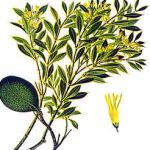| Common Name: |
White Quebracho |
| Other Names: |
Quebracho, naawa |
| Botanical Name: |
Aspidosperma quebracho-blanco |
| Genus: |
Aspidosperma |
| Family: |
Apocynaceae |
| Native Location: |
S American (mainly Argentina) |
| Cultivation: |
Well-drained to sandy soil in sun. |
| Propagation: |
By seed sown when ripe. |
| Harvest: |
Bark is removed as required and dried alkaloid extraction or use in liquid extracts. |
| Height: |
30m (100ft) |
| Width: |
5-12m (20-40ft) |
| Hardiness: |
Min. 15-18°C (59-64°F) |
| Parts Used: |
Bark |
| Properties: |
A bitter, tonic herb that stimulates the circulatory, respiratory, and genito-urinary systems, lowers fevers, and relaxes spasms. |
| Medicinal Uses: |
Internally for asthma, bronchitis, emphysema, and feverish illnesses. Excess causes nausea and vomiting. |
| Warning: |
This herb is subject to legal restrictions in some countries. |
| Bibliography: |
Encyclopedia of Herbs by Deni Brown Copyright © 1995, 2001 Dorling Kindersley Limited Pg 136 |

